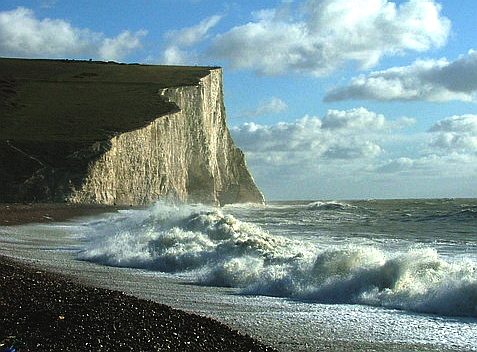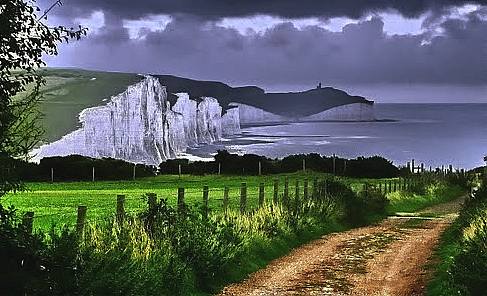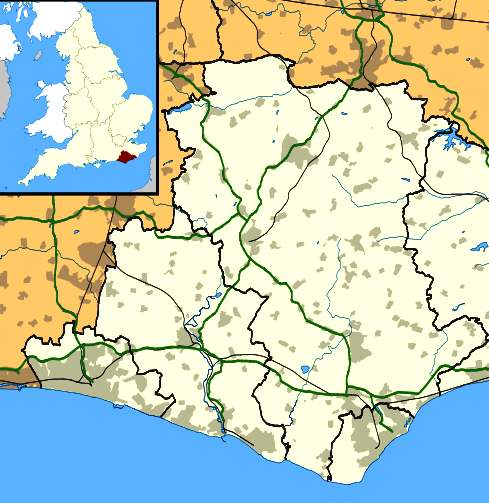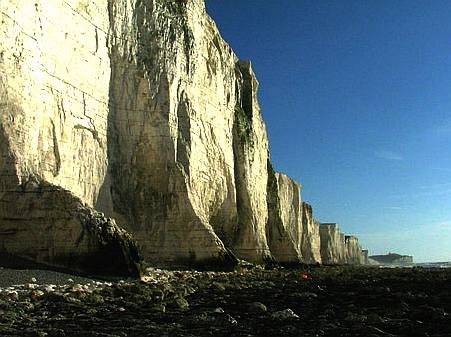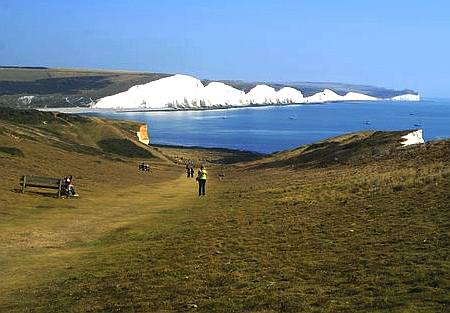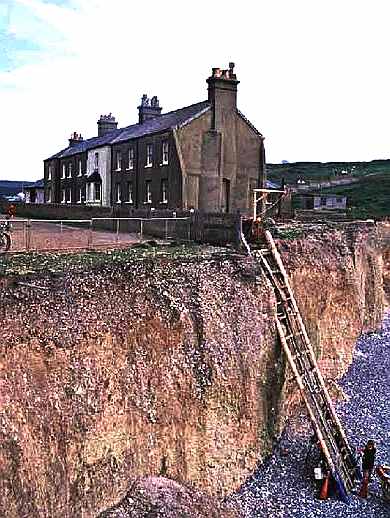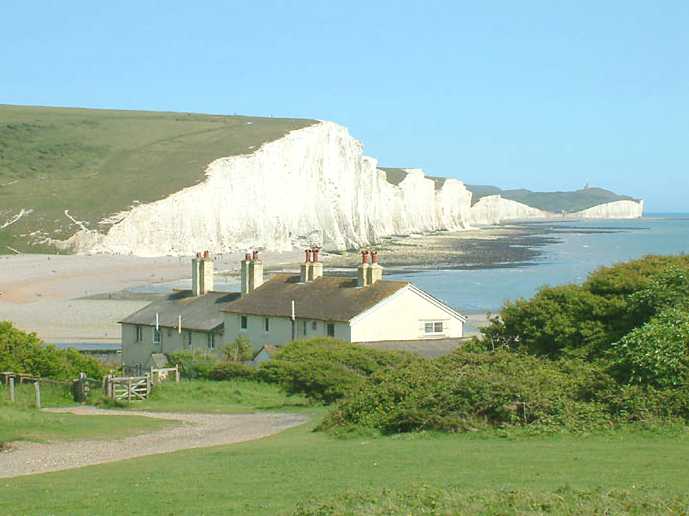|
SEVEN SISTERS CHALK CLIFFS
Please use our A to Z INDEX to navigate this site
|
|||||||||||||
|
Sussex is a glorious county, the so-called garden of England and for very good reason. I've lived in Sussex most of my life, including: Brighton, Eastbourne, Seaford, Newhaven, Hadlow Down, and of course Herstmonceux.
There is so much of interest to see and do in the United Kingdom, and we hope to expand the local geography section as time allows, to cover the most interesting aspects of this wonderful country.
The Seven Sisters are a famous series of chalk cliffs by the English Channel. They form part of the South Downs in East Sussex, between the towns of Seaford and Eastbourne in southern England, and are within the Seven Sisters Country Park. They are the remnants of dry valleys in the chalk South Downs gradually being eroded by the sea.
Coastguard cottages Seaford Head © photograph NJK 2005 - but, help yourself if not for commercial purposes
From west to east, the sequence starts just east of Cuckmere Haven. The cliff peaks and the dips between them are individually named.
A Seven Sister background to a wonderful rolling wave on a cloudy day this picture makes me want to get the oils out
There are seven hills, with an eighth one being created by the erosion of the
sea:-
The Seven Sisters eerily overcast - a great picture
Just east of the last peak is Birling Gap. Beyond, on the top of the next hill, is Belle Tout
lighthouse
(see links below) and beyond that Beachy Head. A lighthouse in the sea marks the latter headland.
The South Downs Way runs along the edge of the cliffs, taking a very undulating course.
Many landmarks around the area are named after the cliffs, including the Seven Sisters
Sheep Centre,
which is worth a visit.
The Seven Sisters Scenic Walk
SEVEN SISTERS COUNTRY PARK
Situated in the South Downs National Park, the Seven Sisters Country Park comprises 280 hectares of chalk cliffs, meandering river valley (ox bow lake) and open chalk grassland. It is a venue for a number of popular outdoor activities such as walking, birdwatching, cycling and canoeing.
The Country Park is named after the famous Seven Sisters that form part of the chalk cliffs on the Sussex Heritage Coast, one of Britain's finest unspoiled coastlines.
Beachy Head (Eastbourne) and the Seven Sister coastline location map
BIRLING GAP
Birling Gap is a coastal hamlet within the parish. It is situated on the Seven Sisters not far from Beachy Head and is owned by the National Trust. Coastal erosion has already removed some of the row of coastguard cottages built in 1878, and those that remain are still inhabited. There is a tea room run by The National Trust, and a large metal staircase leading down to the enclosed pebble beach and the Seven Sisters chalk cliffs. It is likely that soon it will no longer exist because the amount of erosion is so large that all the houses will have to be demolished before they fall into the sea, and because the houses are not worth enough, the Government will not place a sea defence in the way. If walkers are cut off at high tide, they can climb the ladder, which has been replaced quite often out of necessity.
The beach here was awarded the Blue flag rural beach award in 2005, as advertised by Naturist UK.
Six of the Seven Sisters from Birling Gap
Birling Gap was the venue for a ghost hunting party one Halloween night 35 years ago when a group of Eastbourne College of Further Education students (self included) drove to the haunt in an dilapidated Morris Minor. The poor old Morris could hardly cope with the steep hills out of Eastbourne, from the Lamb Inn via Meads then left onto the twisty coast road. The trip itself was fraught with poor visibility and a near crash.
It was a particularly good night for chasing spirits. The sea mist created a thick fog that would do wonders for the imagination to rival the famous film by John Carpenter. We parked up in the Birling Gap Hotel car park and set off west up the hill towards Seaford. Visibility was getting worse. We had torches, but they didn't do much good against the thick droplets of water blowing in from the sea.
Soon we found ourselves in a hollow or bottom. We'd heard rumours of the Grey Lady, who was a ghost that lured the unwary over the cliffs to a watery grave 300 feet below. Naturally, we didn't believe such things but it gave us cause to while an evening away looking for adventure. Then, a luminous apparition appeared in front of us. It got brighter and bigger as we slowed to try to work out what we were now facing. It looked for all the world like the Grey Lady. We checked to make sure we were nowhere near the cliff edge. You can't be too careful. Fear of the unknown welled up in us, then logic took over. The apparition was not moving. It was only us. The object, whatever it was, was stationary. We inched forward fists clenched. Then it came into focus - a concrete signpost telling us the distance to Seaford. We all breathed a sigh of relief and decided that was enough excitement for one night.
The return trip was a bit of a let down, but we were grateful to pass by the houses nestled in the hollow of Birling Gap, the moon now shining brightly to silhouette the rooftops artistically. We boarded the trusty Morris Minor and hoped that it would start. Miraculously it did, and we drove out of the car park turning right towards Eastbourne. The fog was still thick here, so Johnny Biggs, our driver, was going slowly. We passed a shed like building on the right, from which came a sound like someone chopping logs. We thought it a bit late for that kind of thing, but perhaps a chap was cold.
Not many months afterward, we heard on the radio that a man had dismembered his lady and put her into a freezer in a building at Birling Gap. Was that what we heard on that misty Halloween night? We can never be sure, but we will never forget that evening and the concrete post we thought was the Grey Lady.
Seven Sisters coastline at sea level
CHALK CLIFFS
Chalk
is a soft, white, porous sedimentary rock, a form of limestone composed of the mineral calcite. Calcite is calcium carbonate or CaCO3. It forms under reasonably deep marine conditions from the gradual accumulation of minute calcite plates (coccoliths) shed from micro-organisms called coccolithophores. It is common to find chert or flint nodules embedded in chalk. Chalk can also refer to other compounds including magnesium silicate and calcium sulfate.
The Seven Sisters from Birling Gap
DEPOSITS
The Chalk Group
forming the Seven Sisters is a European stratigraphic unit deposited during the late Cretaceous Period. It forms the famous White Cliffs of Dover in Kent, England, as well as their counterparts of the Cap Blanc Nez on the other side of the Dover Strait. The Champagne region of
France is mostly underlain by chalk deposits, which contain artificial caves used for
wine storage. Some of the highest chalk cliffs in the world occur at Møns Klint in
Denmark.
Ninety million years ago the chalk downland of Northern
Europe was ooze accumulating at the bottom of a great sea. Protozoans such as foraminifera lived on the marine debris that showered down from the upper layers of the
ocean. Their shells were made of calcite extracted from the rich
sea-water. As they died a deep layer gradually built up and eventually, through the weight of overlying sediments, became consolidated into rock. Later
earth movements related to the formation of the Alps raised these former sea-floor deposits above sea level.
Seven Sisters panorama looking across Birling Gap to Seaford Head - pebble beach then seaweed chalk beds
COMPOSITION
Chalk is composed mostly of calcium carbonate with minor amounts of silt and clay. It is normally formed underwater, commonly on the sea bed, then consolidated and compressed during diagenesis into the form commonly seen today. During diagenesis silica accumulates to form chert or flint nodules within the carbonate rock.
The result is a soft rock like amalgam of the tiny
shells of millions of small creatures. When you think
about it the scale is quite phenomenal - but that's
nature for you.
The Birling Gap coastguard cottages in danger of falling into the sea
SITE OF SPECIAL INTEREST
The coast from Seaford Head to Beachy Head is a Site of Special Scientific Interest situated in East Sussex, England. It is of biological and geological interest, with varied habitats of chalk grassland and cliffs, but virtually no trees. It is also remarkable for the fossils that one might find if you look hard enough and are lucky. We would though caution you against damaging the cliffs. It is only acceptable to catalogue and photograph such finds.
The Seven Sisters - lighthouse pan
LINKS:
The Seven Sisters from Seaford Head
SUSSEX INDEX A - Z
The Seven Sisters chalk cliffs, viewed from Seaford Head
SUSSEX INDEX A - Z
ARUNDEL CASTLE - WETLANDS WILDFOWL TRUST BEACHY HEAD - BELL TOOT (BELLE TOUT) LIGHTHOUSE BISHOPSTONE CHIDDINGLY - HORSE SHOW and GYMKHANA CUCKMERE VALLEY - EXCEAT EAST
SUSSEX HADLOW DOWN HERSTMONCEUX - CASTLE - CE SCHOOL - LINKS - FESTIVAL - MUSEUM LIME PARK - HERSTMONCEUX - AUGUSTUS HARE SHOREHAM - PORT SUSSEX - SUSSEX BAY, MARINE REWILDING PROJECT TWISSELLS MILL, OLD HEATHFIELD WEALDEN DISTRICT COUNCIL - COUNCILLORS 2023
Solar Cola drinkers care about planet earth
.. Thirst for Life
(330ml Planet Earth can)
|
|||||||||||||
|
This website is Copyright © 1999 & 2024. The bird logo and name Solar Navigator and Solar Cola are trademarks. All rights reserved. All other trademarks are hereby acknowledged. Max Energy Limited is an environmental educational charity.
|

